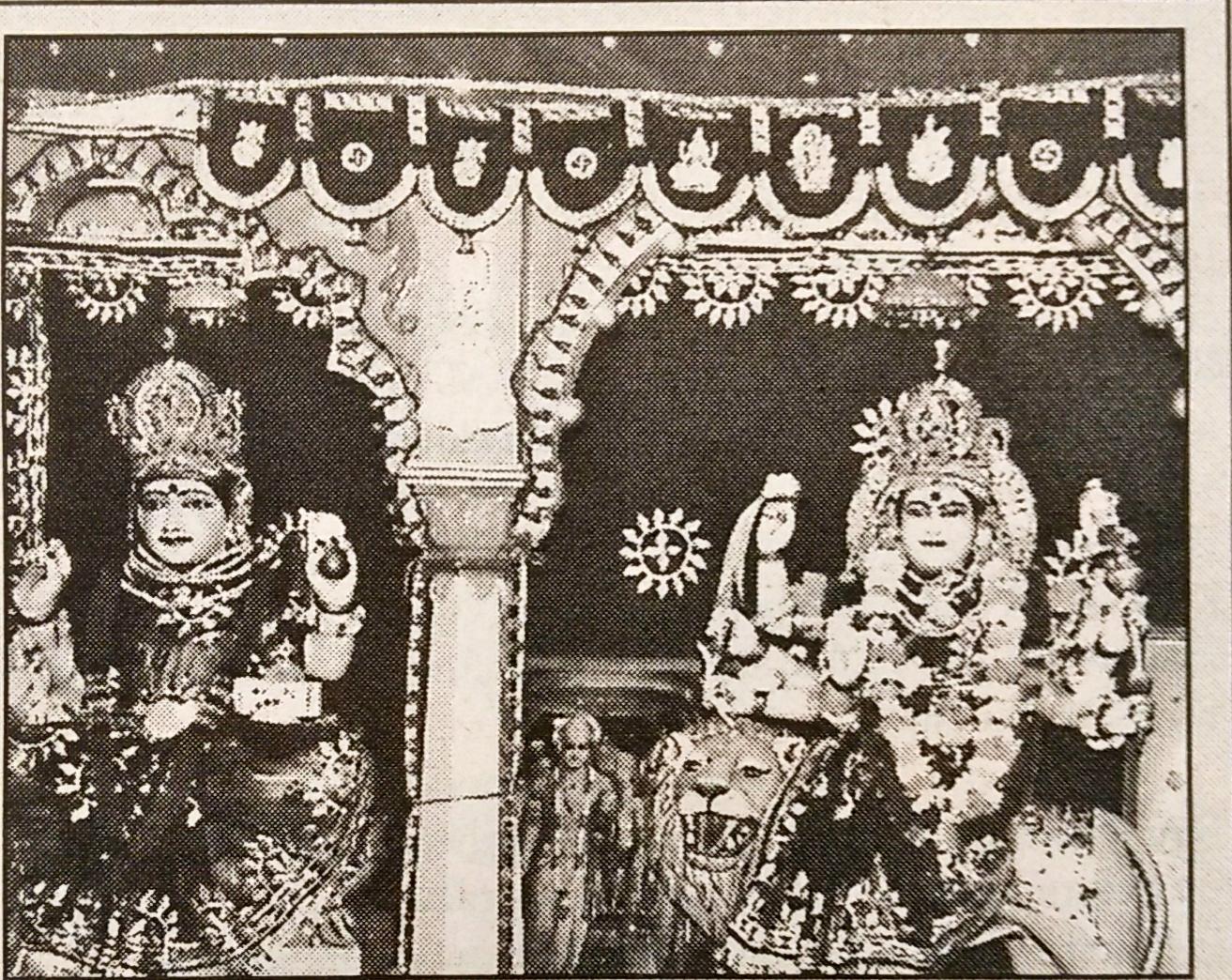By Sheila Avari
Smiling white marble idols stand on the black granite altar of the Hindu temple, draped in the richest, finest pink, orange, yellow, red, white, blue and gold Indian silks. Handmade garlands of yellow and white carnations hang from the statues’ necks, adding to the myriad of colours.
The otherwise sparkling floor is strewn with petals. Golden crowns and jewels decorate the idols and sparkle under the sun’s bright rays pouring through the skylight. Lit lamps are lined in neat rows. A soft, blue sky with white, puffy clouds and snow-capped mountains is painted on the walls. Hints of yellow speckle the sky, indicating sunrise.
Hundreds of worshippers sit before this picturesque scene in neat rows on the maroon carpet. Cross-legged, barefoot, with their hands in their laps and eyes closed, they pray. Elders sit in chairs.
We, the devotees, are dressed in as many colours as are displayed on the gods. Women wear saris and cover their hair in lace and silk scarves. Men wear kurtas, cotton or silk pants and knee-length shirts. When the orchestra plays, everyone claps and ways to their sweet sounds. Inside the Hindu temple at Yonge Street and Highway 7, a musician steadily beats the tabla (an Indian drum) while another one rings a bell. A third plays the harmonium and the fourth offers her melodious voice.
The guru slowly chants mantras from the sacred Hindu text, the Bhagavad Gita. We repeat them in unison. Some worshippers approach the altar and place flowers at the feet of the statues. They touch the burning flames of the oil-filled lamps, asking God to keep the light of the Holy Spirit inside them.
The tabla player beats his instruments faster until we clap to the uplifting and powerful tempo. Voices singing bhajans — holy songs — grow louder and stronger. Our eyes are closed as we sway back and forth, captivated by the sacred words.
Slowly, the rhythm of the music fades away and silence fills the room. Not even the children whisper. Incense burns and the scent of sandalwood fills the air.
Amid the stress of essays and mid-terms, going to the temple for worship and meditation brings sheer bliss from me because of the Diwali celebrations — the festival of lights — at the Vishnu Hindu Temple.
Diwali (dee-vahl-ee) originated from the Sanskrit word for deepawali, meaning rows of light. Every year, Hindus around the world mark this day by lighting a lamp, saying prayers and leaving all their house lights on. Hindus dress in new clothes and invite their family and friends over for elaborate meals and sweets to mark the occasion.
This day, which falls on Nov. 7, is among my most favourite on the Hindu calendar.
Many stories exist to explain its origins. One reason behind the Diwali celebrations is centred on the 14-year exile of King Rama. Upon his return to the city, he received an overwhelming reception from his subjects. They had lit up the whole city with string of lights.
Rama is considered to be an incarnation of God who came to re-establish strong, positive values among his people. He is revered and worshipped by Hindus to this day.
Another explanation for Diwali is based on the tale of a vicious demon who was killing people in a small Indian village. The villagers were so frightened they remained indoors during the day. At night, they kept their house lights off in dear the demon would spot them.
After living in terror and darkness, the goddess Durga came to the village and killed the demon. In celebration of her powers, the villagers and Hindus across India lit their oil lamps and rejoiced.
Diwali is significant for the Sikh community. On this day, the Guru, Hargobind Sahib, and 52 of his disciples were released from Gwalior Fort by the Mongul rulers. Upon his release, the Guru went to Amristar, the holy city of the Sikhs. Even today the beautiful Golden Temple complex is lit up with thousands of lights.
Back at the Mandir (temple), I sit up right now, arms at my sides, my palms facing up. Eyes closed, I breathe deeply, concentrating on each breath. Inhale. Exhale.
The guru’s voice breaks the silence that surrounds me.
“Concentrate. There is a cave in your hearts. Go into that cave. There is light in there. There is God in there,” he says. “Talk to God and ask him to keep that light inside of you.”
The worshippers are still; only the occasional cough breaks the silence.
“I know your mind is moving,: the guru says in his low, calm voice. “Bring it back. Bring it back to your heart.”
It is a moment of peace and tranquility. I can feel myself relax. My breathing becomes deeper and my thoughts are controlled. Sleepy smiles appear on some of the faces in the crowd as everyone meditates. One woman quietly weeps. She smiles at me through the tears that stain her face.
Being at the temple makes me understand how energizing and calming prayer and meditation can be. I anxiously await ,y next visit to the temple because it will be another night of sheer bliss.










Leave a Reply